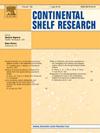利用极值理论分析日本热带气旋的年度数量
IF 2.1
3区 地球科学
Q2 OCEANOGRAPHY
引用次数: 0
摘要
我们利用极值理论预测了 1951-2019 年日本上空台风、北太平洋西部热带气旋、接近台风和登陆台风的年数量极值,以及 1987-2020 年最低中心气压的极值。采用广义极值(GEV)分布拟合极端指数。图中显示了各种诊断图,用于评估与年度台风数、临近台风数和登陆台风数拟合的 GEV 模型的准确性,所有四个诊断图都支持拟合的 GEV 模型。年台风数和台风逼近数的形状参数ξ为负值,台风数有一个有限的上限。计算得出的台风年数和台风逼近数上限分别为 44.5 和 23.2。然而,登陆台风数的ξ为零;因此,登陆台风数没有有限上限,存在发生重大风险的可能性。1951-2019 年台风数量增加。利用地球静止卫星图像估算的 1987-2020 年台风最低中心气压有所下降,强台风数量有所增加。暴台风(≥ 54 m/s)的年数量在 2010 年代有所增加。台风最低中心气压的计算极限为 877 hPa。当太平洋十年涛动(PDO)指数为正值时,往往会出现更多的强台风。本文章由计算机程序翻译,如有差异,请以英文原文为准。
Analysis of the annual number of tropical cyclones over Japan using the extreme value theory
We predicted the extreme value of the annual number of typhoons, tropical cyclones over the western North Pacific, approaching typhoons, and landing typhoons for 1951–2019 over Japan and the minimum central pressure for 1987–2020 using the extreme value theory. The generalized extreme value (GEV) distribution was used to fit the extreme indices. Various diagnostic plots for assessing the accuracy of the GEV model fitted to the annual number of typhoons, approaching typhoons, and landing typhoons are shown, and all four diagnostic plots support the fitted GEV model. The shape parameter ξ for the annual number of typhoons and approaching typhoons is negative, and the number of typhoons has a finite upper limit. The calculated upper limits were 44.5 and 23.2 for the annual number of typhoons and approaching typhoons, respectively. However, ξ in the number of landing typhoons was zero; therefore, the number of landing typhoons did not have a finite upper limit, and there was a possibility that a significant risk would occur. The number of typhoons increased for 1951–2019. The minimum central pressure of typhoons estimated using geostationary satellite images decreased for 1987–2020, and the number of strong typhoons increased. The annual number of violent typhoons ( 54 m/s) increased in the 2010s. The calculated limit of the minimum central pressure of the typhoon is 877 hPa. When the Pacific Decadal Oscillation (PDO) index is positive, more violent typhoons tend to occur.
求助全文
通过发布文献求助,成功后即可免费获取论文全文。
去求助
来源期刊

Continental Shelf Research
地学-海洋学
CiteScore
4.30
自引率
4.30%
发文量
136
审稿时长
6.1 months
期刊介绍:
Continental Shelf Research publishes articles dealing with the biological, chemical, geological and physical oceanography of the shallow marine environment, from coastal and estuarine waters out to the shelf break. The continental shelf is a critical environment within the land-ocean continuum, and many processes, functions and problems in the continental shelf are driven by terrestrial inputs transported through the rivers and estuaries to the coastal and continental shelf areas. Manuscripts that deal with these topics must make a clear link to the continental shelf. Examples of research areas include:
Physical sedimentology and geomorphology
Geochemistry of the coastal ocean (inorganic and organic)
Marine environment and anthropogenic effects
Interaction of physical dynamics with natural and manmade shoreline features
Benthic, phytoplankton and zooplankton ecology
Coastal water and sediment quality, and ecosystem health
Benthic-pelagic coupling (physical and biogeochemical)
Interactions between physical dynamics (waves, currents, mixing, etc.) and biogeochemical cycles
Estuarine, coastal and shelf sea modelling and process studies.
 求助内容:
求助内容: 应助结果提醒方式:
应助结果提醒方式:


